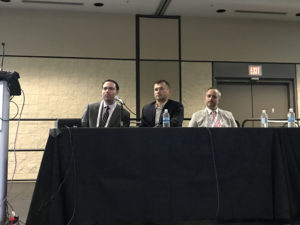Anesthesiologists are frequently called upon to make game-time decisions, the consequences of which can be life and death for the patients on the table. In yesterday’s session “Intraoperative Critical Care: How Best to Succeed When All Seems Lost,” three panelists shared wisdom on how to manage three particularly challenging scenarios:
- Patients with severe aortic stenosis presenting for non-cardiac surgery.
- The diagnosis and management of intraoperative pulmonary embolism.
- The management of patients after intraoperative cardiac arrest.
J. Ross Renew, M.D., an Anesthesiologist at the Mayo Clinic in Jacksonville, kicked off the session by discussing severe aortic stenosis (AS), which is most predominant in patients who are more than 70 years old. Once a patient presents with AS, time is limited.
“88% of these patients are dead within five years,” Dr. Renew said. Upon catching AS in a patient, he said the first question you have to ask yourself is, “What’s their functional capacity?”

Left to right: Craig S. Jabaley, M.D., Roman Dudaryk, M.D., J. Ross Renew, M.D.
Patients who have symptomatic AS versus those who have asymptomatic AS have different options available to them. Non-cardiac surgery (NCS) can safely be performed in asymptomatic AS patients, Dr. Renew said, while symptomatic AS patients may require special considerations.
“A heightened vigilance with meticulous attention to hemodynamics is paramount,” Dr. Renew said. He noted that the long-term outcomes following NCS likely reflect underlying AS and not the NCS and/or anesthetic.
“[AS patients] require extra vigilance intraoperatively and postoperatively,” he said.
Roman Dudaryk, M.D., an Associate Professor of Anesthesiology at the University of Miami, discussed best practices in the diagnosis and treatment of intraoperative pulmonary embolism (PE). Venous thromboembolism (VTE) prophylaxis is not necessarily the one-size-fits-all answer for PE, he said, noting that the absolute risk reduction for VTE prophylaxis is 3%.
A transesophageal echocardiogram (TEE) may not be the right answer to see a clot either, noted Dr. Dudaryk, as the embolus is seen only 46% of the time because the left PA is a TEE blind spot. Clots may be broken with thrombolysis or catheter-based therapy using ultrasounds or mechanical extraction.
Craig S. Jabaley, M.D., an Assistant Professor of Anesthesiology at Emory University, wrapped up the session with a discussion on optimizing long-term outcomes after intraoperative cardiac arrest.
“We’re seeing about a ten-fold improvement since the 1970s,” Dr. Jabaley said. “We as anesthesiologists understand that an ounce of prevention is definitely worth a pound of cure.”
Perioperative cardiac arrest rates have declined with time, to the point where adult cases are an estimated 0.2 to 1.1 arrests per 10,000 and pediatric cases are an estimated 1.4 to 4.6 per 10,000. Vulnerable populations within these statistics include the elderly, neonates undergoing cardiac surgery and patients undergoing emergency surgery.
There are several ways that physicians can work to prevent cardiac arrest, including the use of cognitive aids and simulation such as manuals and checklists, encouraging and normalizing communication within the facility’s culture, and considering human factors like assignment clarity, who and how to call for help, and general communication.
Dr. Jabaley paid special attention to neurologic considerations for intraoperative patients, noting that neurologic injury is the main cause of mortality–or, in survivors, eventual morbidity/functional limitations. Physicians should avoid hyperthermia by keeping a patient at 33 degrees Celsius in a deep coma or, in a less practiced center, 36 degrees Celsius.
Dr. Jabaley advised attendees to consider percutaneous coronary intervention when indicated as well, although the optimal hemodynamic and ventilatory targets remain elusive.
Return to Archive Index